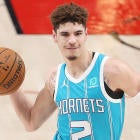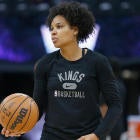
There's a colloquialism that attempts to define the indefinable -- "I know it when I see it." The phrase was most famously and controversially invoked by Supreme Court Justice Potter Stewart in a 1964 case about obscenity, but it also applies to art, film, and even NBA awards races.
In the case of the Charlotte Hornets, not much time passed before they realized rookie LaMelo Ball had "it."
"We all kind of knew his type of game, how he plays, but still when you're out there with him it's still like, 'Hey!' Hornets guard Terry Rozier said. "His first day had us all looking at each other like, 'Damn, this kid can do it!'"
Ball was a bit of an enigma during the pre-draft process due to a shortened high school career that led to extremely limited stints with professional teams in Lithuania and Australia. His draft stock ranged from "franchise player" to "potential bust," largely because there just wasn't much to analyze.
What stood out immediately, even on film, and what made him the No. 3 overall pick in the 2020 NBA Draft, was his vision and passing ability. Both Hornets coach James Borrego and Golden State Warriors coach Steve Kerr, whose team held the No. 2 pick, noticed those elite skills before the draft -- the question was always whether his game would translate to the NBA.
But once Ball got on the court during the preseason, it was clear that wouldn't be a problem.
"I noticed in training camp, just the type of passes he was making. He wasn't looking at guys and hitting them right on the money. It's been like that since Day 1," Hornets forward PJ Washington said. "Everybody knows him, everybody knows he's gonna find you wherever you are, so whenever he's on the court you've just got to be ready to catch the ball and shoot it. He's gonna find you whenever you're open."
And find open guys, he has. The 19-year-old Ball is averaging 6.4 assists per game this season and is a nightly staple in highlight videos with his wide array of fanciful dishes. He's also much further ahead in the other aspects of his game than most anticipated. He's on pace to join Oscar Robertson, Magic Johnson, Ben Simmons and Michael Carter-Williams as the only NBA rookies to average at least 15 points, six rebounds and six assists per game. He's shooting 36.7 percent from the 3-point line, a much higher rate than most expected given his pre-NBA percentages and unorthodox shooting form.
Even with all of his other talents, which have combined to make Ball the leading Rookie of the Year candidate, the elite passing and vision are what could eventually turn him into an All-Star, an All-NBA player or even a Hall of Famer.
"A good passer's almost like a good shooter," Kerr said. "When the ball comes off his fingers, it just looks softer. It looks like it's going to be completed, it's going to the right spot with good timing. You see all that with LaMelo."
It's hard to get deeper than "I know it when I see it" without hearing from someone who interacts with Ball on a daily basis. So I asked Borrego what, in his mind, distinguishes an elite passer from, say, a good passer. He went into great detail, as only a veteran coach can, which helps us get a better understanding of what specifically makes Ball so special.
"To me, the elite passers, playmakers, they can make these passes and reads on all three levels," Borrego said.
What are those three levels, exactly? I'm so glad you asked.
Level 1
"So, when I initially beat my defender, whether it's out of a pick-and-roll or just straight beat him one-on-one, the ability to make that play," Borrego said, describing the first level of playmaking, "a lot of guys, they can see that. They can make that first read."
Here are a couple of examples of that "first read" Borrego is talking about, and how Ball excels in that area. On the surface, this may seem like a simple lob play called by the coach. But Ball has a quick and crucial read to make. If Bucks forward Bobby Portis stays with the cutting Miles Bridges, who has just slipped the screen, Ball can hit Washington for an open 3-pointer. But Ball anticipates Portis cheating up for a split-second, and delivers a perfect lob to Bridges for a highlight dunk:
In this play against the Raptors, Ball draws two defenders off a pick-and-roll, reads Fred VanVleet helping on the rolling Washington and delivers a one-handed, over-the-shoulder pass on-target to Devonte' Graham for the open 3-pointer:
These are split-second decisions that need to be executed perfectly, and Ball rarely fails to deliver. But, as Borrego says, a lot of NBA point guards can make those reads. Let's take a look at the second level.
Level 2
"That middle-tier read is pretty tough. I get downhill and now I'm kind of around the free throw line area, and now I've got to make another decision," Borrego said. "That's another level of playmaking -- in that midrange area. I get down there, now the defense starts to shift; what's my next read? The elite guys can make that play."
Watch here, as Ball uses the pick to get past Jrue Holiday, then has a decision to make between the rolling Bridges or Rozier flaring out for an above-the-break 3-pointer. Ball reads Giannis Antetokounmpo sticking with the cutter and makes another on-the-money delivery to Rozier, who doesn't have a defender within 20 feet of him:
Then on this play, again from the free throw line area, Ball somehow sees Cody Zeller cutting in heavy traffic, and gives him a lead pass for a wide-open layup:
When NBA minds talk about Ball's elite vision, this is what they mean. He sees the play unfold before it ever happens, knowing that this situation is somehow going to turn into an easy basket for his team.

The third level of playmaking, however, is what Borrego says distinguishes the truly special passers.
Level 3
"Then you have the top tier that -- now I get to the rim area -- and now I can make the read and make the pass. So not only do I see it, but I can execute it," Borrego said. "When a big guy, a 7-footer's coming to block my shot, I can still execute a pass to get the ball out of there. That's not easy to do. You've got to have great size, or the ability to wrap it, or get up in the air and skip it. The elite passers, and I think Melo's in this category, he can make those plays and reads at all three levels -- not only make the read, but execute it. So yeah, he's special that way."
You see this with players like LeBron James and Luka Doncic, who have the ability to get deep into the lane and somehow find the narrowest passing lanes to deliver frozen ropes right into the pocket of open 3-point shooters. Ball's already doing the same thing, as you can see in this play against the Raptors. With Chris Boucher trailing him and Pascal Siakam ready to block his shot, Ball doesn't break stride as he delivers a one-handed bullet pass to the weakside corner for a wide-open Bridges 3-pointer:
Here, Ball uses that same vision among the trees to find Bismack Biyombo for a layup with a wraparound lefty dish:
You can break down all the video you want, but there's still something ethereal about the way Ball plays. He pushes pace, always looking for an open teammate, but he remains under control. He makes spectacular passes but thrives on executing the simple play. Of course, he occasionally commits turnovers, as any young point guard will, but he's turned the ball over at a lower frequency (2.8 per game) than both Trae Young and Luka Doncic did during their rookie seasons. Borrego has pulled Ball from games after bad turnovers, but ultimately he knows that he needs to let Ball take risks, since it's an essential part of his basketball DNA.
"He's gonna have to make some aggressive plays. That's who he is, and I've got to live with some of those turnovers," Borrego said. "Those kick-aheads over the top where he's looking for bigs or Miles [Bridges] at the rim -- those are built out of aggressiveness. ... I've got to give him freedom to be who he is, but the sloppy ones, the ones that are in traffic, those are the ones that we can clean up."
Most importantly, Ball impacts the game in a way you rarely see from players his age. He makes his teammates better and, by continually finding the open man at a breakneck pace, he's endeared himself to his teammates and impressed opponents. He's already helped make Charlotte one of the most exciting young teams in the NBA after being largely ignored on the national scale for the last several years.
"I think the big thing is just the energy that he brings to the game. You can tell that people like playing with him and he's fearless out there," Kerr said. "He loves to play. He really is -- not solely responsible -- but a huge part of [the Hornets] building this identity that they've built already. So he's gonna be a great player, if he's not already."

















